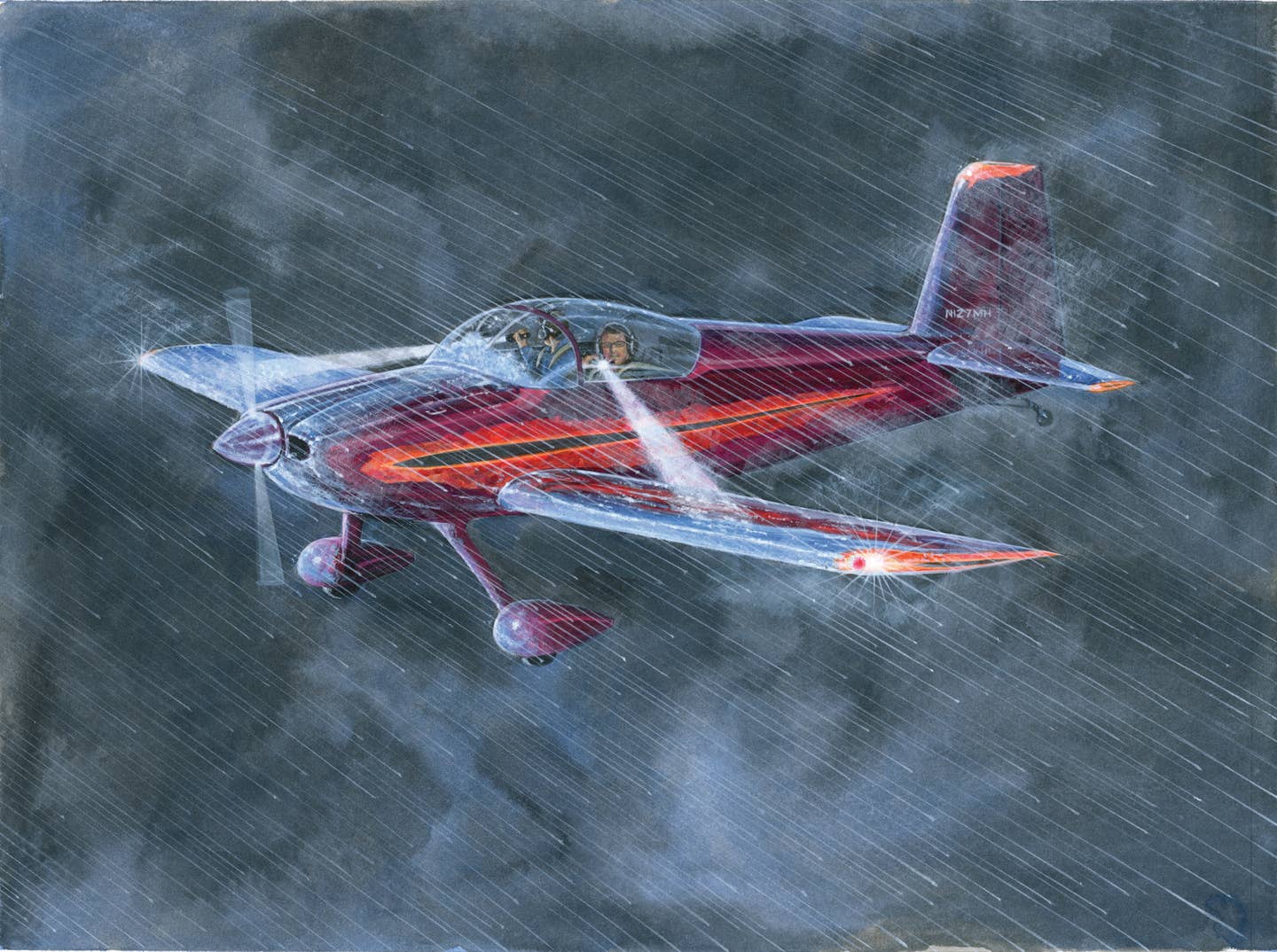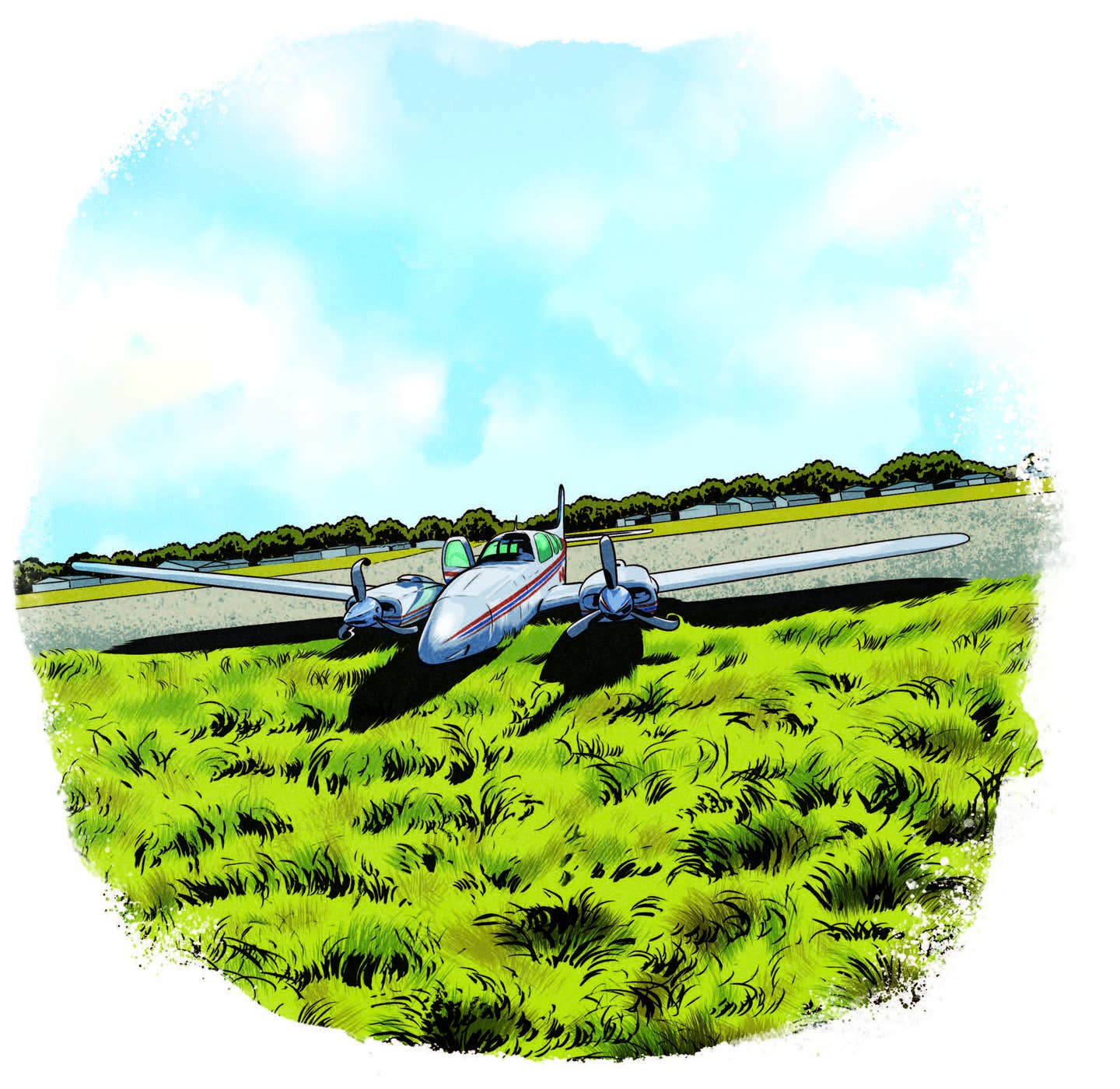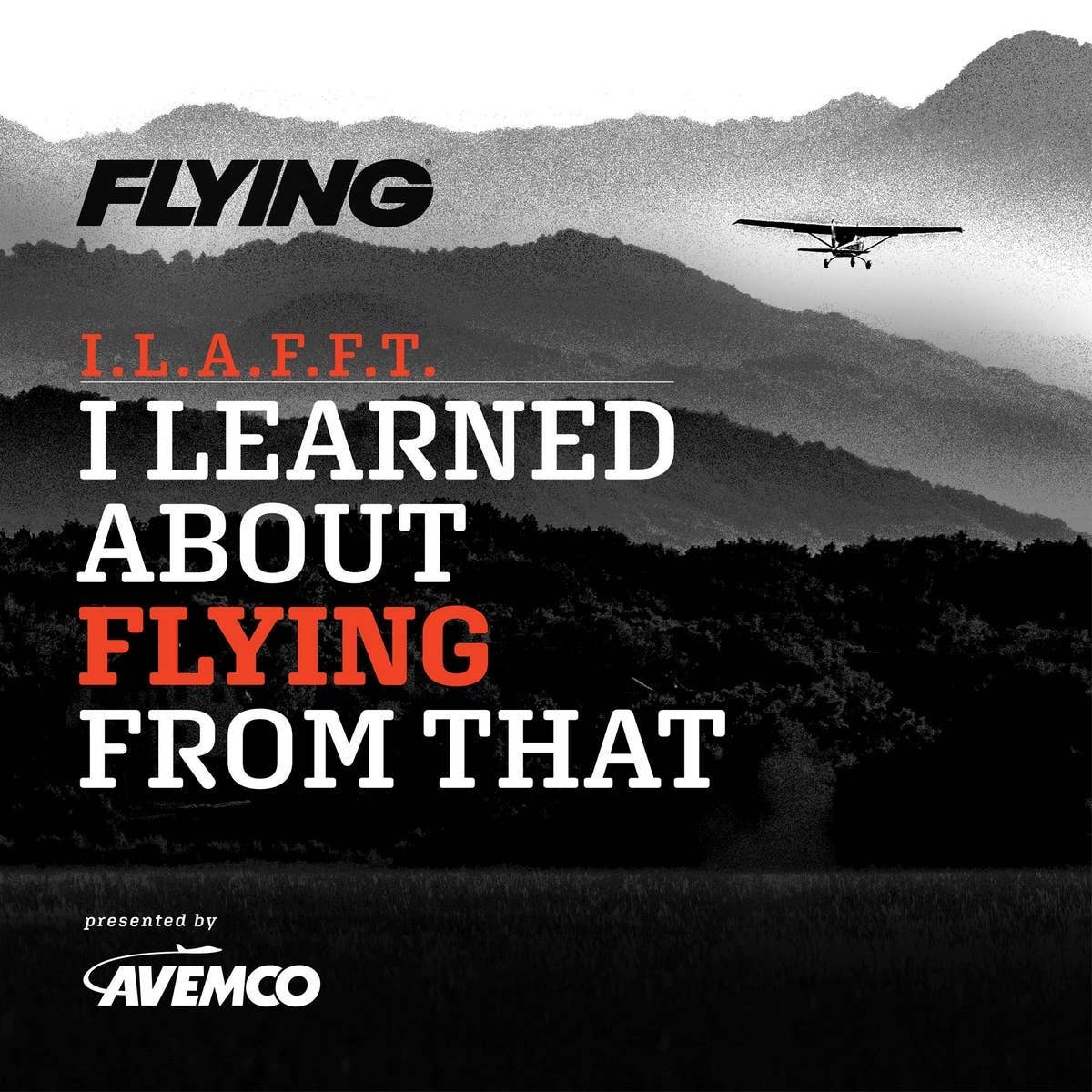
To see more of Barry Ross’ aviation art, go to barryrossart.com Barry Ross
People like to ask, “What was your favorite flight?” There are so many, I wouldn’t know how to choose. But ask me to choose my least favorite flight, and I can tell you in a heartbeat. It started on a beautiful February day. My buddy Shaun decided to join me. We made a lot of good decisions during that flight, except one: taking off.
That time of year in San Diego brings some rain and a few storms. We were grounded for most of the week, but things cleared by the day of my talk in Las Vegas — an easy 80-minute flight in our Van’s RV-7. Checking my iPad, I saw the weather looked VFR, but I called Flight Service on the way to the airport as a final check. I gave 10,500 feet as my highest altitude and a six-hour total time there and back. It would be a quick visit to Vegas. I’d deliver a short presentation and get right back home. Flight Service confirmed no adverse weather conditions. We had a gorgeous outbound flight. I gave a brilliant lecture on heart valves and then immediately returned to the airplane. It was turning dark, so I used my iPad to file an IFR flight plan back to San Diego. Our RV-7 is an Experimental homebuilt. It doesn’t have a lot of bells and whistles, but it’s nicely outfitted for IFR with a Dynon glass panel. We departed just after sunset into the pitch-black desert night.
We were at 10,000 feet in the middle of the desert, mountains on all sides and my eyes glued to the instruments, when Shaun said, “We’re in a cloud.” I looked up. Each flash of our strobe lights screamed “you’re in IMC.” We had been flying only 20 minutes. “Wow,” I said. “I thought this was going to be VFR conditions. Good thing I filed IFR.” Not three minutes later, Shaun said, “It’s raining.” I got a chill and said: “That’s a problem. That’s not rain. It’s 29 degrees out there. Take the flashlight and check the wings.” Shaun scanned the surface and confirmed, “We’ve got ice on the wings.” There was about a half-inch of gritty-looking white foamy stuff on our leading edge. In the four years and 1,600 hours since I had started flying, it was the first time I felt terror. My response was funny only in retrospect. I said passionately, “We’ve gotta do something!”
I immediately asked for lower, and ATC gave me 9,000. The outside air temperature rose a whopping 1 degree. That was not going to do it. So I asked again and got 8,000. Now the OAT was 31 degrees — not going to work. When I asked for lower a third time, we were told “unable.” The minimum en route altitude for our airway was 8,000 feet.
So we evaluated our options. We were almost halfway to San Diego. We could cancel IFR and descend another 1,500 feet, which might be enough to melt the ice. Let me think about this: It’s pitch dark, I’m in the middle of the desert, I’ve got ice on my wings, there’s terrain on all sides, and I’m going to cancel IFR. It took about a tenth of a second to rule out that option.
I asked for an immediate 180 and got it. We had been in icing conditions for only about five minutes. If we reversed now, it would likely be clear skies in another five. It was the obvious choice and the one we all learned in flight school.
ATC asked if we had deicing equipment on our aircraft. Not on an RV-7. “Do you want to declare an emergency?” Ah, no. What was that going to accomplish? They wouldn’t give us lower, and they wouldn’t vector us off the airway. We just needed to get out of this cloud and then get to lower terrain.
I made the 180-degree turn very slowly. The RV-7 is labeled an Experimental, but now I was flying an experimental Experimental aircraft. With ice on the wings, we didn’t know its stall speed or any other characteristics. Irregular patches of granular ice started to form on the windshield. We were silent as we each shined a flashlight on the wings. As we moved away from the mountainous terrain, I again asked for lower. It took a few tries to even get a response: negative. ATC didn’t seem to share our terror. It was a very long 10 minutes. Then we exited the cloud.
The skies were clear now, and the airplane was still flying. We had ice on the wings, but it wasn’t accumulating. As soon as ATC let us, we descended to 7,000 and saw welcome streaks of moisture on the windshield. We talked about making a no-flap landing or circling the airport until all the ice melted. Finally, we saw the lights of Las Vegas and ATC let us descend further. I started to breathe again as we watched shrouds of ice fly off our windshield and wings. By the time we turned final, our wings were clear, so we put the flaps in and made a routine landing. It was dark and desolate at the airport, but we got to tell our story to the guy in the fuel truck.
A quarter-inch-thick flat pane of ice was still glued to our cowling and spinner. We spent the night in Las Vegas and returned to San Diego the next morning.
Mistakes we made: I did not check the weather again for the return trip. I had a mindset that this was just one quick day trip there and back, yet on our return, many hours had passed since I had checked the weather. That’s the problem with the weather: It changes. The regulations say you cannot fly into known icing conditions without anti-icing equipment (FAR 91.527). I did not know icing conditions had developed, but I should have known. According to FAR 91.103, “Each pilot in command shall, before beginning a flight, become familiar with all available information concerning that flight.”
As soon as Shaun said we were in clouds, we should have begun working the problem. Visible moisture in below-freezing conditions is nowhere to be, especially without deicing equipment. We could have saved a few minutes of icing or avoided it altogether had we turned around immediately.
We had weather on the Dynon and did not use it. If you have weather information in the cockpit, why not use it?
We did not declare an emergency. Most pilots to whom I tell this story say they would not have declared an emergency either. They say: “Why bother? ATC will not do anything differently.” But I have been convinced by others this was an error. Icing is, after all, an emergency. ATC might have asked for pilot reports and found less icing at higher, not lower, altitudes. Maybe we would have been rerouted. At least we would have been talked to more. Instead, we were decidedly not a priority.
We put in flaps to land. We could see there was no longer ice on the wings, but upon exiting the airplane, there it was on the cowling, and we hadn't realized it. There could have been ice on the tail.
Flying across the desert and over mountains at night in a single-engine airplane can always be criticized, of course. I’m sure you can think of other mistakes we made.
Things we did right: I brought along a smart pilot friend. I was glued to the instruments. If Shaun hadn’t noticed the clouds and precipitation, when would I have realized I was in trouble? When my airspeed started to decay? By then it might have been too late.
We didn’t freak out. We turned around. We turned on the pitot heat. We filed IFR for the night flight across the desert. We had flashlights. And we each got to experience something wonderful back at the hotel: two vodka martinis.

Sign-up for newsletters & special offers!
Get the latest FLYING stories & special offers delivered directly to your inbox






